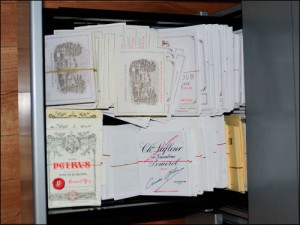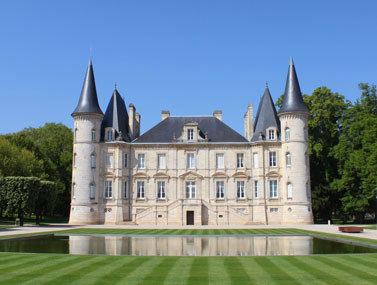Recent Blog Posts
- Fine Wine Investment Seminar, Wednesday 12th February 4/02/2014
- The Wine Advocate’s Grand World Tour 2014 20/01/2014
- Fighting Counterfeit 11/11/2013
- The Classés of 2012: Trends over the past year 4/10/2013
- Bordeaux 2010: The Latest Opinion 22/02/2013
Trending
Ten most searched-for wine names*- 1. Dom Perignon2. Petrus3. Pin4. Montrose5. Cristal
- 6. Talbot7. Angelus8. Belgrave9. Krug10. Palmer
wine investment BLOG
Fine Wine Investment Seminar, Wednesday 12th February
Date posted: February 4, 2014
Provenance would like to invite you to our next monthly Fine Wine Investment Seminar, held at our premises in central London on Wednesday 12th February.
If you are looking for risk-adjusted capital growth then this is the ideal opportunity to gain an expert insight into what fine wine can offer you as an investment asset class. One of our Senior Portfolio Managers will present an overview of the market including:
- Key market drivers and how they affect investment
- Reasons for investing in fine wine
- How to invest easily, safely and profitably
There will be no “hard sell”; the aim is to introduce you to the fine wine investment market and what we can offer you as your service provider, while hopefully slaying a few myths in the process. It is also a chance to ask us your questions directly, face-to-face. This isn’t an hour of tasting and discussing the enjoyment of wine – as nice as that would be, our interest in wine is whether or not it will perform as an investment.
There is no charge for attending but spaces are limited so please register via the details below. Don’t worry if you are unable to attend this time as our seminars are held on the second Wednesday of every month (with the following date being 12th March).
What: Provenance Fine Wines one hour wine investment seminar, hosted by Andrei Knight, Senior Portfolio Manager
When: 6-7pm, Wednesday February 12th 2014
Where: The Grosvenor Room, Provenance Fine Wines, 140 Buckingham Palace Road, London SW1W 9SA
To register: Call 020 7881 2620 or email admin@provenancefinewines.co.uk
Read full story...
The Wine Advocate’s Grand World Tour 2014
Date posted: January 20, 2014
Fighting Counterfeit
Date posted: November 11, 2013
From the high-profile arrest of Rudy Kurniawan in March 2012, to the recent arrests of several individuals accused of faking €2 million worth of Domaine de la Romanée-Conti wine, counterfeit wine is perhaps the defining issue for the fine wine industry in recent years.
The issue is not new, of course. Controversies surrounding wines from Hardy Rodenstock , as recounted in Benjamin Wallace’s page turner The Billionaire’s Vinegar, date back to the 1980s. Yet the more recent expansion of the fine wine market into China have increased the opportunities and incentives for wine forgeries, as highlighted by the recent series of articles by Nick Bartman on Jancis Robinson’s Purple Pages (3 out of 5 articles for subscribers only). An unofficial estimate by French publication Sud Ouest (subsequently reported on by others) estimated that 20% of the market for fine Bordeaux and Burgundy consists of fake wine. Though the estimate seems rather high, it’s another indicator of a widely-recognised problem.

If there was a sure-fire way of detecting the fakes then of course the problem could be eradicated and wealthy connoisseurs could sip their Pétrus and sleep easy. A recent technical development in the scientific quarter of the Vinosphere might suggest we are closer to this becoming a reality.
A team at California’s Los Gatos Research led by Manish Gupta has developed a machine capable of analysing the isotopes contained within wine to determine whether it has been adulterated. It can also determine the origin and age of the wine. Crucially, Gupta’s team have developed a machine able to do this at a much lower cost than previously possible - $45,000 per machine rather than $200,000.
The problem being that if we open the bottle to test the wine then it’s too late; if it’s genuine you’ve already killed it. Enter the Coravin, a device that claims to allow users to take samples from bottles without removing the cork. If the sales literature is correct, this would allow a small but sufficient sample to be taken from a suspect bottle without ruining the precious fermented grape juice.
Yet even if all the above is correct, the testing is still not perfect. An isotopic analysis could only go so far in verifying whether the liquid in the bottle matched the text on the label – for example, it could narrow it down to appellation but not vineyard. For the time being this technology appears to be a useful tool but not a panacea. The role of actual human experts such as wine-sleuth Maureen Downey seems secure for the time being. But at heart, didn’t we all know that wine is far too subjective and to allow, dispassionate cold science to have that final word…?
Kurniawan’s trial is set to start next Month in New York (though reports last week suggest he may claim to be mentally unfit for trial) and is set to be a suitably dramatic occasion, generating even more headlines about the world of counterfeit wine. In the meantime, it’s incumbent on the wine trade to retain a cool-headed critical approach to fine and rare wines that could be too good to be true. Read full story...
The Classés of 2012: Trends over the past year
Date posted: October 4, 2013
It has been over a year since the chateaux of Saint Emilion gained a new classification. As we have reported previously, the ranking is not without its discontents, nevertheless the 2012 Classification stands intact. The headline-grabbing change was the upgrade of Angélus and Pavie to the highest rank of Premier Grands Crus Classés ‘A’ to join the Right Bank royalty alongside Cheval Blanc and Ausone. With the benefit of a year’s worth of trading data we can now see how the upgrade has affected wine prices for the two estates – at least in the short term.
As the Liv-ex Blog reported last week, prices for ten vintages (2000 – 2009) of both estates have shown a strong upward trend, with Angélus showing an even greater level of growth than Pavie. Neither however has yet reached the prices of their Classé A stable mates Ausone and Cheval Blanc. Indeed, it would be somewhat troubling for the market if a wine jumped from around £2,300 a case (such as Angelus 2005 in September 2012) to the region of £12,000 a case (Ausone 2005 in the same month) in a single year!
Yet it does indicate the impact of classification, not just critical rating, on wine prices. The Robert Parker scores for all vintages up to 2009 were known for both Pavie and Angélus, yet a change in ranking has still significantly affected the price the market is willing to pay for them.
In another earlier blog post, Liv-ex also indicated the relative strength of the Right Bank 100 index compared to indices that emphasised Left Bank wines – a condition no doubt strengthened by the reclassification in Saint Emilion. A comparison of six wines, all from the 2009 vintage, all given 99 or 100 points by Robert Parker, shows the recent trends between these difference Bordeaux regions over the past 12 months. The top three wines are Left Bank while the bottom three wines are all from Saint Emilion:
While showing strong growth over a two-year period, the Left Bank wines have moved up only by 2-3% in the past 12 months. In contrast, the Saint Emilion wines in the table above have all shown double-digit growth in the same time period. While some eyes in the market are looking outside Bordeaux (to Tuscany, California and elsewhere) it’s important to remember the different recent trends in prices within Bordeaux itself.
Read full story...
Bordeaux 2010: The Latest Opinion
Date posted: February 22, 2013
While the châteaux of Bordeaux are busy bottling their 2010 vintage, and as we’re busy delivering cases of it to our clients, the world’s professional wine critics have re-tasted the vintage to give their latest assessments. It seems a propitious moment for a brief roundup of opinion on Bordeaux 2010, just a week or so before the biggest voice of all, Robert Parker Jr., issues his latest scorings in the March issue of The Wine Advocate. Overall, though it now seems safe to say that Bordeaux 2010 is an exceptional vintage.
The 2010 vintage has been touted as a second successive great vintage after the 2009, though the two are very different in style. The earlier vintage is characterised by a fruit-driven, generous palate, while the later vintage is considered classically-styled, well-structured, and outstanding. Neil Martin (of the Wine Advocate stable) has analogised the vintages as Beatles albums: 2009 as ‘Sgt. Pepper’s Lonely Hearts Club Band’ and 2010 as ‘The White Album’ - that is, both legendary in their own ways.
Martin has been busy publishing in-depth and very favourable assessments of each of the Bordeaux appellations in his Wine Journal section of eRobertParker.com. He has saved particular praise for the wines of Pauillac, granting Latour 2010 a rare 100-point score (comparing it only to those legendary vintages 1982 and the 1961), Lafite Rothschild a 99+ and Mouton Rothschild a 98. Outside the First Growths, Pichon Baron (scored 97) and Pontet-Canet (scored 95) were singled out for praise, with Martin preferring the 2010 vintage of each to the 2009s.*

Château Pichon Baron: One of our favourite ‘Super Seconds’ from 2010.
In recent weeks, James Suckling (previously of Wine Spectator and now operating via his website www.JamesSuckling.com) has called 2010 a ‘truly superb’ and ‘compelling’ vintage. Eleven wines were awarded a perfect 100 points on Suckling’s rating scale, compared to the nine ‘100-pointers’ in the 2009. Mouton-Rothschild, Le Pin, Latour and, reaffirming its reputation of punching above its weight, Pontet-Canet are among Suckling’s 100-point wines of 2010.
Robert Parker’s indications so far are positive. In his initial assessment he named it as one of the greatest vintages of his career with ten estates being given potential 100-point scores. In a recent tweet, the man himself noted the vintage was ‘as reported – a top vintage’, but he’s given little else away. Whether his re-scoring this year will lead to movements in price similar to what happened with the 2009 vintage last year remains of course to be seen.
For what it’s worth, our tasting of the vintage at the Union des Grands Crus de Bordeaux tasting in Covent Garden last November confirmed in our minds the superb quality of the vintage, even at this early stage: poised and truly delicious. Our opinions, however, do not move the market like Parker’s!
*All Copyright The Wine Advocate. Read full story...
Archives
- March 2014
- February 2014
- January 2014
- December 2013
- November 2013
- October 2013
- February 2013
- January 2013
- December 2012
- November 2012
- October 2012
- September 2012
- August 2012
- July 2012
- June 2012
- May 2012
- March 2012
- February 2012
- January 2012
- November 2011
- October 2011
- September 2011
- June 2011
- April 2011
- March 2011
- February 2011
- January 2011
- December 2010
- November 2010
- October 2010
- September 2010
- August 2010
- July 2010
- June 2010
- May 2010
- April 2010
- February 2010
- December 2009
- November 2009
- October 2009
- September 2009
- August 2009
- July 2009
- June 2009
- May 2009
- April 2009
- March 2009
Auction News
- Weekend Wine Auctions Raise $18 million wine-searcher.com, 25/03/2014
- Hart Wine Auction Totals $5.05 Million as Lafite ’82 Leads Sale businessweek.com, 25/03/2014
- Sotheby’s hails success of Drouhin direct cellar auction decanter.com, 11/03/2014
